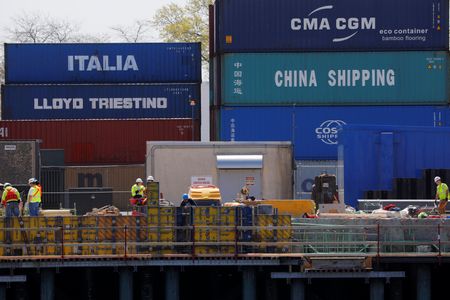By Lucia Mutikani
WASHINGTON (Reuters) – The U.S. trade deficit in goods narrowed in May as imports fell, but the improvement was probably insufficient to prevent trade from being a drag on economic growth in the second quarter.
The hit from trade on gross domestic product was, however, likely to be offset by a rise in inventory investment, with the report from the Commerce Department on Wednesday also showing retail inventories increasing strongly last month.
A raft of upbeat data this month, including nonfarm payrolls, retail sales, durable goods orders and housing starts, have suggested that the economy remained on a steady growth path in the second quarter, defying growing fears of a recession.
The goods trade deficit decreased 6.1% to $91.1 billion last month, leaving the bulk of April’s surge intact.
“Even with the narrowing in May, the goods trade deficit is up by over 10% since March, and trade will likely be a drag on economic growth in the second quarter,” said Abbey Omodunbi, a senior economist at PNC Financial in Pittsburgh, Pennsylvania.
Imports dropped 2.7% to $254.0 billion. While the decline in imports helped shrink the deficit, it suggested that domestic demand was softening. The drop was led by a 7.3% plunge in consumer goods imports. Industrial supplies imports, which include crude oil, fell 5.9%. Food imports slipped 3.0%.
But capital goods imports rose 1.3%, a good omen for business investment. Imports of motor vehicles and parts increased 0.9%.
Exports of goods fell 0.6% to $162.8 billion, pulled down by a 14.2% tumble in food shipments. Industrial supplies exports dropped 3.0%. But the nation saw an 8.7% jump in exports of motor vehicles and parts. Consumer goods exports vaulted 4.3% and shipments of other goods increased 2.4%.
Trade made no contribution to the economy’s 1.3% annualized growth rate in the first quarter after adding to GDP for three straight quarters.
The report also showed that retail inventories increased 0.8% last month after gaining 0.3% in April. Motor vehicle inventories shot up 2.9% following a 1.6% advance in the prior month. Excluding motor vehicles, retail inventories were unchanged after decreasing 0.3% in April.
This component goes into the calculation of GDP. Wholesale inventories dipped 0.1% last month after dropping 0.3% in April.
Private inventory investment rose at its slowest pace in 1-1/2 years in the first quarter, chopping off 2.10 percentage points from GDP growth in that period.
The Atlanta Federal Reserve is currently estimating second-quarter GDP rising at a 1.8% rate.
(Reporting By Lucia Mutikani; Editing by Chizu Nomiyama)











